
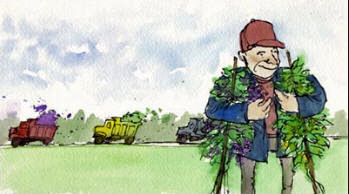
High End Supplier to Wineries in other appellations, Clarksburg's charm has been its easygoing, low profile but thanks to the quality of its grapes, that's all changing now.
The Secret AVA: Clarksburg
by
Jean Deitz Sexton
June 16, 2009
 estled along the Sacramento Delta waterways, the Clarksburg AVA, about 20 minutes outside downtown Sacramento off of I-5 South, is largely known for growing white varietals, the dominant grapes being Chardonnay, Chenin Blanc, Pinot Grigio and Sauvignon Blanc. However, Clarksburg Wine Growers Association President Tim Waits says there is some shift to more red varietals being planted, owing to the increase in customer demand.
estled along the Sacramento Delta waterways, the Clarksburg AVA, about 20 minutes outside downtown Sacramento off of I-5 South, is largely known for growing white varietals, the dominant grapes being Chardonnay, Chenin Blanc, Pinot Grigio and Sauvignon Blanc. However, Clarksburg Wine Growers Association President Tim Waits says there is some shift to more red varietals being planted, owing to the increase in customer demand.
Clarksburg has historically been known for Petite Sirah but there has also been an increase in Merlot and Zinfandel plantings. Wine lovers may be aware of Lodi grapes from the Delta wine growing region but the sleeper is Clarksburg, an old-timey northern Delta town which anchors the Clarksburg AVA (American Viticultural Area) in which 14,000 acres are planted to grapes.
The AVA has largely been a growers’ market, with multigenerational farming families lending Clarksburg a peaceful, settled vibe. The area gained AVA status in 1987 but its agricultural roots date back to the 1860s when the Bogle family settled in the area, first
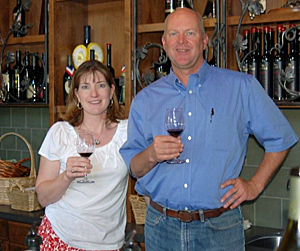
Jody-Bogle with director of winemaking, Chris-Smith
Bogle Vineyards is the most powerful brand in the Clarksburg AVA, and really the only high-volume winery with national distribution, producing more than a million cases annually. However, while credited with creating the Clarksburg AVA, Bogle is avoiding, for the most part, using the AVA designation on its labels. “If you’re selling wine in New York City, they don’t know Clarksburg but they do know California, “ says Smith. Bogle does sell some smaller lots of Clarksburg designate wines out of its tasting room.
Some growers are seeing the beginning of customer recognition of the Clarksburg AVA. Ken Wilson of Wilson Vineyards has 800 acres planted to grapes, and similar to Bogle, his family has a long farming history, theirs dating back to 1922. About 35 percent of his crop is Chardonnay, with other major varietals being Chenin Blanc, Sauvignon Blanc, Pinot Noir and Petite Sirah.
Wilson, who supplies fruit to Don Sebastiani & Sons, to the Diageo Chateau & Estate Wines portfolio and Beringer, among others, is seeing wineries starting to use the Clarksburg designation, as well as putting his own Wilson Vineyards name on their labels.
“Wineries using the Clarksburg designation put a positive light on us,” says Wilson. “Not
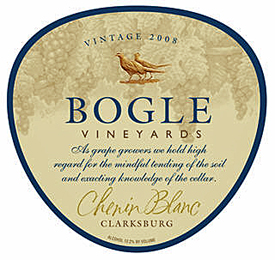 only consumers but also winery people can see what kind of quality wine can be produced from Clarksburg fruit.” Case in point: Dry Creek Vineyards 2007 Chenin Blanc is produced from Wilson’s fruit and uses the Clarksburg AVA on the label.
only consumers but also winery people can see what kind of quality wine can be produced from Clarksburg fruit.” Case in point: Dry Creek Vineyards 2007 Chenin Blanc is produced from Wilson’s fruit and uses the Clarksburg AVA on the label.
Chenin Blanc? Huh?
Known back in the day as a value priced jug style wine, Chenin Blanc is now experiencing a certain quality cachet as wineries such as Sonoma County’s Dry Creek Vineyards and Napa Valley’s Pine Ridge produce high end versions, both using Wilson fruit. The 2008 Pine Ridge Chenin Blanc-Viognier blend gives credit to Wilson and Clarksburg as one of its Chenin Blanc sources.Chenin Blanc “still is a challenging varietal,” says Wilson, “but this is the best place to grow Chenin Blanc in all of California.” He farms 60 acres of the grape. Wilson says the varietal likes a Mediterranean climate which he says describes Clarksburg. The marine influence from the Delta keeps things cooler than nearby Sacramento, which easily gets into triple digits in the summer. There is also high fog in August which helps to cool down the air during the morning, says Wilson.
While Chenin Blanc is the second largest white varietal planting in the Clarksburg AVA, according to the Clarksburg Wine Growers Association – Chardonnay being the first – Wilson does not expect
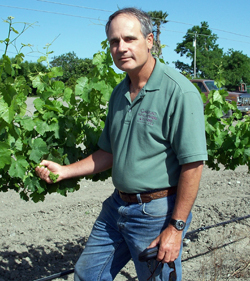
Tim Waits, President of the Clarkburg Wine Growers Association
Newcomers
Clarksburg is attracting newcomers who can buy land for growing grapes at a fraction of the cost of marquee name AVAs such as the Napa Valley. “You can buy raw dirt for about $10,000 an acre and then add another $10,000 per acre on to establish a vineyard,” says Tim Waits, who purchased a 340 acre ranch, of which 75 acres are planted to Pinot Noir and 60 acres to Petite Sirah. He already has a contract with Gallo for the Pinot Noir and with Bogle for the Petite Sirah. Waits may expand to another 60 acres or more of grapes in the future.Waits bought the land in 2004 after selling his medical equipment company to Apria. He chose the Lake Winchester area in Clarksburg, having spent years as a water skier on the lake. While Pinot Noir is not one of the dominant local varietals, Waits says “Pinot Noir has been the big kid on the block since the film Sideways and Pinot works well here
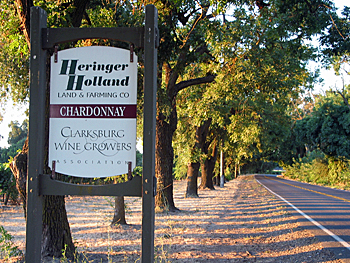 since the cooling night time breezes of the Delta mimic the Carneros and Russian River appellations, where some of the best Pinot is grown.”
since the cooling night time breezes of the Delta mimic the Carneros and Russian River appellations, where some of the best Pinot is grown.”
Interestingly, Waits bought the ranch without a specific crop in mind. He talked to long time local grape grower Steve Heringer and his son Mike. “They were generous in helping me. I picked their brains and made a decision to plant grapes.”
The 6th generation Heringer family owns 400 acres in the Clarksburg AVA, of which 150 acres are planted to grapes, predominantly Petite Sirah and Chardonnay. Five years ago, the family decided to expand ambitiously to new varietals, and now has some plantings in, among others, Barbera, Cabernet Franc, Tempranillo and Viognier. The family has a small, 2,000 case p










 READER FEEDBACK: To post your comments on this story,
READER FEEDBACK: To post your comments on this story,




